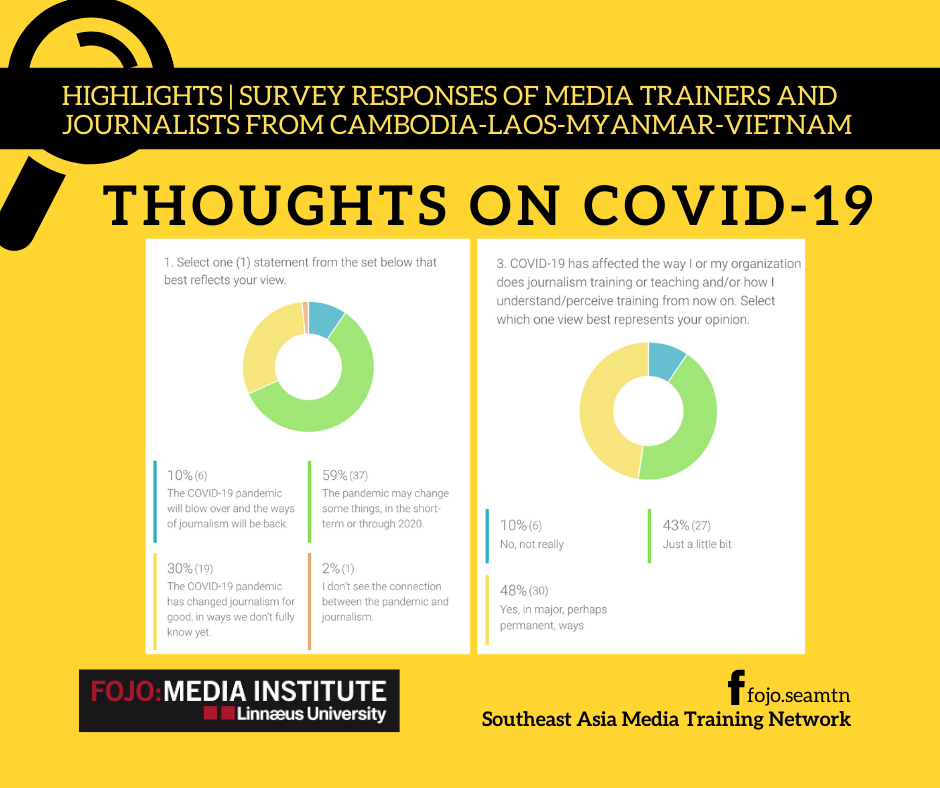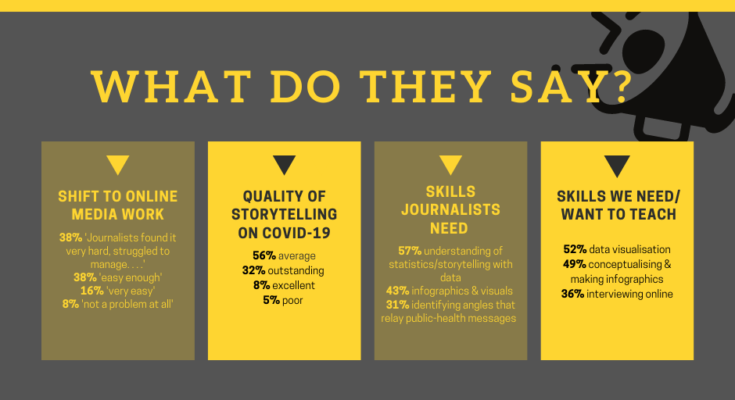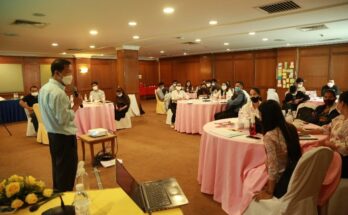How to use data for better storytelling and how to produce infographics topped the online skills that journalists, trainers and news professionals from Cambodia, Laos, Myanmar and Vietnam (CLMV) say are most needed in order to stay with COVID-19 as a long-running story.
In a survey undertaken by the Southeast Asia Media Training Network (SEAMTN) of Fojo Media Institute, majority of the 74 respondents singled out the value of handling statistics and creating infographics – both as skills that journalists need to be better in, as well as those that training groups and educators need to brush up on so they can teach them to others too.
‘Understanding/analysis of statistics, storytelling using data’ emerged as the top skill that respondents to the 10-point survey questionnaire said the journalists in their country needed the most during COVID-19. Fifty-seven percent of respondents chose this skill the most when asked to identify three among a list of seven skills needed during the pandemic.
A close second, chosen by 43% of respondents, was ‘producing infographics and visuals’ and the third (41%) was ‘explaining science and health in an interesting, reader-friendly and accurate way’.
These responses emerged from a 10-point questionnaire in a survey called ‘COVID-19 and Other Media Disruptions’, which the SEAMTN project conducted from mid-August to mid-September 2020. A total of 42% of the 74 respondents were from Vietnam, followed by 30% from Myanmar, 22% from Cambodia and 7%, Laos. Fifty-seven percent of respondents were men and 43% women.
Nearly half (49%) have been in journalism for 6 to 10 years (27%), or 10 to 15 years (22%). Sixty-nine percent are staffers and 19% are managers. Just over half, or 51%, are from online media outlets, followed by 24% from media training institutes.
Aimed at drawing out reflections from journalists, editors, trainers, managers and other media professionals amid the pandemic environment, the survey and responses to it provided local perspectives at a web event arranged by the Fojo Media Institute at the Splice Beta event in September 2020.
Taken together, the responses show that while media professionals agree that using statistics, presenting them as visuals, as well as explaining science and health issues in a reader-friendly way, are wanted and needed, they and their organisations do not always have the skills to impart these to others.
JOURNALISM VS PANIC, MISINFORMATION
One television journalist was, in effect, defining quality reporting when she said that in her survey replies journalists need “the ability to handle information relating to COVID-19 to ensure (that it does) not make citizens freak out and not to be subjective at the same time”.
Good journalism is by itself a major tool in combating misinformation, disinformation and confusion. “Pandemic information needs to be delivered to readers quickly, accurately and transparently, to eliminate fake news from spreading on social networks,” added a senior editor from Vietnam.
“We really need these (data skills) in the newsroom,” said Sao Phal Niseiy, editor-in-chief of Cambodianess, the English-language news website of ‘Thmey Thmey’ news group, said at a 5 September discussion held by SEAMTN on the CLMV media environment, the pandemic and the Fojo-published ‘Online Journalism and Storytelling: A Learning and Training Kit’.
Over in Laos, the Lao Youth Radio team found out that putting together infographics from government data around COVID-19 made these much more understandable, apart from drawing many more followers on its social media and messaging channels. “We turned everything into infographics,” Lao Youth Radio founder Bounheng Southichak told a separate September discussion that Fojo’s SEAMTN project organised at the Splice Beta event.
(Click here to watch the 17 September 2020 discussion with CLMV journalists in the time of COVID-19 and other media disruptions.)

A total of 52% of media professionals selected ‘doing data visualisation’ as the skill they believe they or their organisations ‘want to/need to teach and conduct training in, in the COVID-19 context’. Almost the same percentage – 49% – chose ‘conceptualising and making infographics’ as the skill they believed they need and want to teach.
HOW READY ARE YOU?
Going further, the survey asked the respondents to indicate ‘how ready and capable are you and your organisation to teach/train journalists’ in the same seven skills they were asked to select the three most-needed skills by journalists from.
On the skill of ‘understanding/analysis of statistics’, only 7% assessed their readiness to teach this at the highest level, or having ‘extremely good capacity’. Most of the respondents, 64%, rated their readiness at ‘some limited capacity’ or ‘average capacity’. A total of 26% chose ‘good capacity’ and 3% replied that they had ‘no capacity’.
In the second most-needed journalistic skill of producing infographics and visuals, the most number of respondents or 39% said they had ‘some limited capacity’, followed by 33% saying their capacity was ‘average’. Eight percent said they had ‘extremely good capacity’, and 5% said ‘no capacity’.
In the third most needed skill of ‘explaining science and health in an interesting, reader-friendly and accurate way’, 52% rated themselves and their organisations as having ‘average capacity’ in it.
The insights on skills acquire more depth when they are placed beside the responses to two other questions — how well they thought journalists reported on COVID-19, and how journalists managed the shift to online journalism, from home.
More than half, or 56% of respondents, said pandemic coverage by the journalists in their countries was average, followed by 32% who found it outstanding, 8% excellent and 5% poor.
GAME CHANGER
When it comes to the shift to online ways of doing news work amid COVID-19, an equal percentage (38%) of respondents chose these two replies – first, that journalists in their country ‘found it very hard, struggled to manage with some adjustment’ and second, that they found this change’ easy enough’. A total of 16% said their journalists found this ‘very easy, with smooth transition’.
Zooming out to the bigger picture, the responses to the survey’s questions on how media professionals look at COVID-19 and its impact on their view of the news profession and their work reflect how CLMV media professionals see journalism through the lens of uncertainty.
Replies to two other questions point to the recognition by a good number of media professionals that COVID-19 has, and will continue, to change the way journalism is done, perhaps permanently, and in ways they do not yet fully know. Views differed, however, around the extent of the pandemic’s impact on journalism.
Asked to select which best reflects their own view from a list of four reflections on COVID-19 and the media, 59% chose this statement: ‘The pandemic may change some things, in the short-term or through 2020.’ The next most selected thought (30% of respondents) was ‘the COVID-19 pandemic has changed journalism for good, in ways we don’t fully know yet.’
When combined, the two responses make for a total of 89% that recognise that the pandemic is, or is likely to, cause at least some shift in journalism. Ten percent said the pandemic “will blow over and the ways of journalism will be back”.

The survey also asked respondents their opinion about this sentence: ‘COVID-19 has affected the way I or my organisation does journalism training or teaching and/or how I understand/perceive training from now on.’
To this question, 91% of respondents said the pandemic has some impact on their own views and approach to media-related work. This percentage comprises 48 percent that said ‘yes, in major, perhaps permanent, ways’ and 43% that chose ‘just a little bit’. Only 10% said COVID-19 has no effect on how they think about, or approach, their work.
The insights from this CLMV-focused survey shows how COVID-19 is, indeed, a long-running story in more ways than one. It is not just a topic of news coverage, explanation and risk communication to audiences, but may well drive some reflection and rethinking in newsrooms and media training organizations as well as among journalists themselves.
(This article is originally posted on Fojo Media Institute website and written by Johanna Son, the Bangkok-based founder/editor of the Reporting ASEAN series, and a consultant for Fojo’s SEAMTN project. She designed the survey discussed in this article.)



